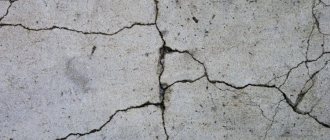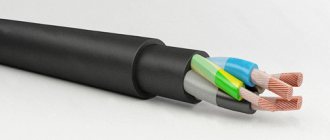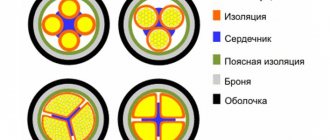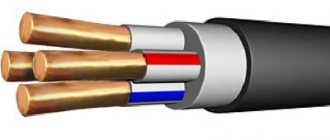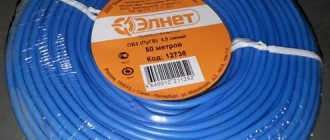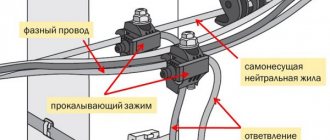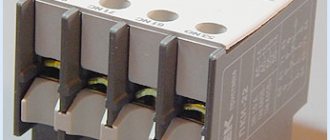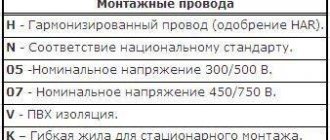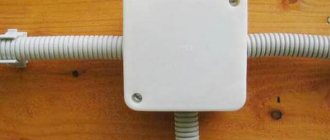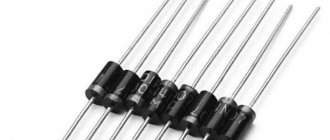The industry does not stand still. Old technologies are being brought to perfection, new ones are being born. Every day the number of electrical tools and household appliances operating from a 220/380 V network is significantly increasing. Accordingly, there is a need to use a unified, standard cable that could be used to connect electrical appliances to the network. Looking ahead, we note that this is what it is.
The specific choice is influenced by the features and operating conditions. It is important to choose the most durable, electrically and fireproof cable with increased flexibility and long service life. In addition to PVA, the best option for household appliances, there are other, less popular types of wires.
However, PVA can be operated at AC voltages up to 380 V, which is an ideal value for domestic use. Among the advantages, plasticity should be highlighted, which is influenced by the minimum bending radius. This allows you to maintain the integrity of the insulation and reduce the risk of ruptures of internal conductors.
Purpose and use of PVS
In general, the purpose of the cable can be judged based on the last letter of the marking - “C”, which stands for “connecting”. It turns out that the product is intended for switching electrical devices among themselves or connecting to a network.
The PVS wire is used mainly at home. It can be used to create several products:
- extension;
- switching of electrical devices;
- arrangement of temporary lighting systems.
The cable can often be found in various manufacturing plants where medium power equipment is switched, including lathes, power units and control terminals. PVA wire for domestic and industrial use differs in the number and cross-sectional area of the cores. A wide variety of options allows you to find the right model in accordance with your requirements and operating conditions.
Construction, appearance
The design of the PVA wire is clearly visible in the photo. Twisting the conductor from thin copper strands gives flexibility. The number and diameter of veins determine the total cross-section. Copper cores can be tinned or have a galvanic coating to prevent oxidation.
The twisted core is covered with an elastic layer of multi-colored vinyl insulation. Conducting insulated conductors (1-10 pieces) are twisted and filled with soft PVC outer shell, forming a monolith without voids. The shape is round in cross section. Models that increase tensile strength use a central dielectric rod.
The arrangement of conductors in one row forms a flat product of the PVSP brand.
The shell must be intact, without dents, bulges, or cracks. Separating the cores from the sheath is easy.
Markings that allow you to determine technical characteristics and facilitate selection are applied to the outer shell.
The letters indicate the brand, the numbers indicate the number of conductors (2-7), the cross section is written through X (0.5-10.0 mm²).
The designation PVA 3x4 shows Vinyl Insulated Connecting Wire, 3 conductors have a cross-section of 4.0 mm² each.
Decoding of PVA markings
It is quite simple to decipher the PVA:
- the letter “P” indicates that this product is a “wire”;
- the letter “B” means that the cores and sheath are protected with “polyvinyl chloride” (vinyl) insulation;
- “C” – “connecting” cable (purpose).
There are other wire options. For example, you can often find the PVSP label on store shelves. Many people mistakenly believe that we are talking about an identical cable, although in fact the cores of this model are located parallel to each other. As a result, the wire turns out to be oval in cross-section, and installers call it “flat”.
Any cable/wire must be marked on the outer surface. In addition to letter designations, there may be various numbers on the PVA shell:
- the first digit is used to indicate the number of cores, so the number will always be an integer - 2, 4, 5, 8, etc.;
- the second number indicates the cross-sectional area of an individual core - 0.25, 0.75, etc. (measured in sq. mm).
It will be much easier to understand by looking at examples. Let's assume that you see a cable marked PVS 4×0.75. Deciphering the meaning, we get “a connecting wire with polyvinyl chloride insulation and four cores with a cross-section of 0.75 square meters. mm for each." If the product is marked as PVSP 2×2.5, then this cable is a flat type of PVSP with two cores and a cross-section of 2.5 square meters. mm each.
There is more complex marking when the cable indicates “PVS 4×0.5+1×1.0. This wire has four cores with a cross section of 0.5 square meters. mm and one additional – 1.0 sq. mm.
Important! In accordance with GOST, small deviations are allowed between the actual and nominal values of the cross-sectional area of the wire. Thus, this value may be less or more than declared, while the electrical resistance must be the same as indicated in the technical data sheet. This is the main technical parameter!
PVA wire structure 3×4 sq.mm (Dn=11.02 mm, P=0.222 kg/m)
- The current-carrying core of the PVA wire is copper or tinned copper (at the consumer’s request, when ordering, the letter “l” is added to the wire grade, as well as in wires intended for reinforcement with permanent fittings and in version T), round in shape, stranded, class 5 according to GOST 22483.
- PVA wire insulation from PVC plastic compound.
- PVA wire twisting - insulated cores are twisted without filler. Insulated cores of five-core wires can be twisted around the core.
- The sheath of the PVA wire is made of PVC plastic. The sheathing in the wires is applied to fill the spaces between the wires, giving the wires a round shape.
Varieties
PVA can be divided into several varieties depending on the methods of operation and design. We are talking about internal and external, as well as copper and aluminum wires.
More details about each PVA option:
- The outer cable at least consists of three conductors, indicating phase, neutral and ground. This wire can be used to connect transformers and distribution panels.
- The internal one also consists of three cores, but is mainly used inside residential and industrial premises.
- Copper PVA is characterized by low resistance, elasticity and high strength.
- These indicators are no worse than those of aluminum cable. It is much cheaper, but is considered outdated technology.
The cost of a specific cable depends on several parameters:
- section;
- manufacturer;
- terms of Use;
- number of meters in the bay;
- technical execution;
- distance to the manufacturer (how much money was spent on transportation).
Design
Modern PVA wire consists of several intertwined copper wires with separate insulation made of high-quality polyvinyl chloride. Additionally, all conductors are protected by a PVC sheath. The standard cable has a round cross-section, although the PVSP model, as described above, will have an oval cross-section. Insulating materials may include various additives that give them additional protective functions (for example, the product does not support the combustion process).
Each copper core contains a large number of copper wires. When twisting each one, a dense rope is formed. In accordance with GOST, the class of lived in PVA must be at least fifth. Such a standard automatically regulates the minimum thickness of the wires from which a separate core is formed.
If the cross-section of each core in the cable is 1 sq. mm, then the diameter of the wires used should not be lower than 0.21 mm.
According to the standards specified in GOST, the wire can be produced in the following versions: with two, three, four or five cores. The cross-sectional area varies between 0.75-16 square meters. mm. Thicker types of cable are produced in specialized factories and are necessary for industrial use.
Analyzing GOST, you can discover another important rule: in PVA, the cores are twisted in the left direction, but the density is so high that filler is not used.
When choosing an insulating shell, manufacturers try to use materials of different colors, which simplifies installation tasks. Individual wires can be colored blue, brown, red, yellow or even yellow-green. The phase conductor is usually marked brown or red, the neutral conductor is blue or cyan, the ground conductor is double, yellow-green. The common sheath, under which all the cores are located, can have an arbitrary color (for example, black).
The top, outer layer is a polyvinyl chloride shell, which is applied using the extrusion method. During the single installation process, the protective layer does not support combustion. Due to its plasticity, the sheath fills any gaps formed between the cores, making the wire round in shape. The maximum eccentricity value is 10%.
Cable cross-section
The cable cross-section is the cut area of the current-carrying core. If the cut of the core is round (as in most cases) and consists of one wire, then the area/section is determined by the formula for the area of a circle. If there are many wires in the core, then the cross-section will be the sum of the cross-sections of all the wires in this core.
The cross-sectional values are standardized in all countries, and the standards of the former CIS and Europe in this part completely coincide. In our country, the document that regulates this issue is the “Rules for the Construction of Electrical Installations” or briefly - PUE.
The cable cross-section is selected based on the loads using special tables called “Permissible current loads on the cable.” If you have no desire to understand these tables, then it is enough for you to know that it is advisable to use a copper cable with a cross-section of 1.5-2.5 mm² for sockets, and 1.0-1.5 mm² for lighting.
To introduce one phase into an ordinary 2-3 room apartment, 6.0 mm² is quite enough. All the same, your 40-80 m² will not fit larger equipment, even taking into account the electric stove.
To “estimate” the required cross-section, many electricians believe that 1 mm² of copper wire can pass 10A of electric current through itself: accordingly, 2.5 mm² of copper can pass 25A, and 4.0 mm² - 40A, etc. If you analyze the cable cross-section selection table a little, you will see that this method is only suitable for estimation and only for cables with a cross-section no higher than 6.0 mm².
Below is an abbreviated table for selecting cable cross-sections up to 35 mm² depending on current loads. For your convenience, the total power of electrical equipment is given there for 1-phase (220V) and 3-phase (380V) consumption.
When laying the cable in a pipe (i.e. in any closed spaces), the possible current loads on the cable should be less than when laying it openly. This is due to the fact that the cable heats up during operation, and heat transfer in a wall or in the ground is much lower than in open space.
When the load is called in kW, we are talking about the total load. Those. for a single-phase consumer, the load will be indicated for one phase, and for a three-phase consumer - in total for all three. When the load value is named in amperes (A), we are always talking about the load on one core (or phase).
Load table for cable cross-section:
| Sech. cab. mm² | Open wiring | Hidden wiring | ||||||||||
| copper | aluminum | copper | aluminum | |||||||||
| current, A | power, kWt | current, A | power, kWt | current, A | power, kWt | current, A | power, kWt | |||||
| 220V | 380V | 220V | 380V | 220V | 380V | 220V | 380V | |||||
| 0.5 | 11 | 2.4 | ||||||||||
| 0.75 | 15 | 3.3 | ||||||||||
| 1 | 17 | 3.7 | 6.4 | 14 | 3 | 5.3 | ||||||
| 1.5 | 23 | 5 | 8.7 | 15 | 3.3 | 5.7 | ||||||
| 2.5 | 30 | 6.6 | 11 | 24 | 5.2 | 9.1 | 21 | 4.6 | 7.9 | 16 | 3.5 | 6 |
| 4 | 41 | 9 | 15 | 32 | 7 | 12 | 27 | 5.9 | 10 | 21 | 4.6 | 7.9 |
| 6 | 50 | 11 | 19 | 39 | 8.5 | 14 | 34 | 7.4 | 12 | 26 | 5.7 | 9.8 |
| 10 | 80 | 17 | 30 | 60 | 13 | 22 | 50 | 11 | 19 | 38 | 8.3 | 14 |
| 16 | 100 | 22 | 38 | 75 | 16 | 28 | 80 | 17 | 30 | 55 | 12 | 20 |
| 25 | 140 | 30 | 53 | 105 | 23 | 39 | 100 | 22 | 38 | 65 | 14 | 24 |
| 35 | 170 | 37 | 64 | 130 | 28 | 49 | 135 | 29 | 51 | 75 | 16 | 28 |
To independently calculate the required cable cross-section, for example, for entry into a house, you can use a cable calculator or select the required cross-section from the table.
This table applies to cables and wires with rubber and plastic insulation. These are such widespread brands as: PVS, GDP, VPP, PPV, APPV, VVG. AVVG and a number of others. Paper-insulated cables have their own table, and non-insulated wires and buses have their own.
When calculating the cable cross-section, the specialist must also take into account the methods of laying the cable: in trays, in bundles, etc. In addition, the values from the tables on permissible current loads must be adjusted by the following reduction factors:
- correction factor corresponding to the cable cross-section and its location in the block;
- correction factor for ambient temperature;
- correction factor for cables laid in the ground;
- correction factor for different numbers of operating cables laid nearby.
Calculation of cable cross-section
Let's start not with a table, but with a calculation. That is, each person, without having the Internet at hand, where the PUE with tables is freely available, can independently determine the cable cross-section by current. To do this you will need a caliper and a formula.
If we consider the cross-section of the cable, it is a circle with a certain diameter. There is a formula for the area of a circle: S = 3.14*D²/4, where 3.14 is the Archimedean number, “D” is the diameter of the measured core. The formula can be simplified: S=0.785*D².
If the wire consists of several cores, then the diameter of each is measured, the area is calculated, then all the indicators are summed up. How to calculate the cross-section of a cable if each core consists of several thin wires?
The process becomes a little more complicated, but not much. To do this, you will have to count the number of wires in one core, measure the diameter of one wire, calculate its area using the described formula and multiply this figure by the number of wires. This will be the cross section of one core. Now you need to multiply this value by the number of cores.
If you don’t want to count the wires and measure their sizes, you just need to measure the diameter of one core, consisting of several wires. You must take measurements carefully so as not to crush the core. Please note that this diameter is not exact because there is space between the wires.
Relation between current and cross section
To understand how an electrical cable works, you need to remember a regular water pipe. The larger its diameter, the more water will pass through it. It's the same with wires.
The larger their area, the greater the current that will pass through them, the greater the load such a wire can withstand. In this case, the cable will not overheat, which is the most important requirement of fire safety rules.
Therefore, the cross-section - current connection is the main criterion that is used in the selection of electrical wires in the wiring. Therefore, you need to first figure out how many household appliances and what total power will be connected to each loop.
| Wire core cross-section, mm2 | Copper conductors | Aluminum conductors | ||
| Current, A | Power, W | Current, A | Power, W | |
| 0.5 | 6 | 1300 | ||
| 0.75 | 10 | 2200 | ||
| 1 | 14 | 3100 | ||
| 1.5 | 15 | 3300 | 10 | 2200 |
| 2 | 19 | 4200 | 14 | 3100 |
| 2.5 | 21 | 4600 | 16 | 3500 |
| 4 | 27 | 5900 | 21 | 4600 |
| 6 | 34 | 7500 | 26 | 5700 |
| 10 | 50 | 11000 | 38 | 8400 |
| 16 | 80 | 17600 | 55 | 12100 |
| 25 | 100 | 22000 | 65 | 14300 |
For example, the kitchen must have a refrigerator, microwave, coffee grinder and coffee maker, an electric kettle and sometimes a dishwasher. That is, all these devices can be turned on simultaneously at the same time. Therefore, the total power of the room is used in the calculations.
You can find out the power consumption of each device from the product passport or on the tag.
For example, let's designate some of them:
- Kettle – 1-2 kW.
- Microwave and meat grinder 1.5-2.2 kW.
- Coffee grinder and coffee maker – 0.5-1.5 kW.
- Refrigerator 0.8 kW.
Having found out the power that will act on the wiring, you can select its cross-section from the table. We will not consider all the indicators in this table; we will show those that prevail in everyday life.
Colors
Standards have been adopted around the world according to which manufacturers usually color conductor cores depending on their number, as well as the presence or absence of grounding.
The table below shows these standards:
| Number of cores | Color standard | |
| Grounding conductor – yes | Absent | |
| 2 | – | Brown and blue |
| 3 | Yellow-green, brown and blue | Black, brown and blue |
| 4 | Yellow-green, black, brown and blue | Blue, black, brown, black and brown |
| 5 | Yellow-green, blue, black, brown and black/brown | Blue, black, brown, black/brown, black/brown |
If any two colors are separated by a slash, then the right to choose a specific one remains with the manufacturer.
Depending on the color of the insulation, the cores have a unique purpose:
- blue color – neutral conductor;
- yellow-green – grounding;
- black or brown – phase.
Important! Often the phase core is painted white, which is also acceptable in accordance with international standards.
Operating conditions and technical specifications
An important condition for the operation of PVA wires of any model is maintenance in the operating temperature range, which ranges from -35 to +40 degrees. Celsius. If you follow this rule and exclude mechanical damage, the cable will last for ten years.
Due to its high technical and operational characteristics, PVS is significantly superior to wires of other brands. However, there is only one drawback - the price. However, the reasons for the higher cost are quite obvious.
We list the main technical parameters prescribed in GOST:
- For production, cores with a flexibility class of at least five are used. In accordance with this requirement, the cross-section of the wires used to form the core is selected. For example, 0.21 sq. mm each for a cable with cores of 1.0 sq. mm or 0.26 sq. mm for 2.5 sq. mm.
- The specific thickness of the insulating layer for an individual core and the entire wire as a whole depends on their cross-section. For cores, the thickness range is 0.6-0.8 mm, for sheath - 0.8-1.2 mm. When choosing this value, you need to focus on the electrical resistance specified in GOST.
- The operating temperature range of PVA wire is from -35 to +45 degrees. Celsius (for some versions below - from -25 to +40). The maximum permissible value when heating the cable is +70 deg. Celsius, and installation must be carried out at a temperature of at least -20 degrees. Celsius.
- The polyvinyl chloride shell is flame retardant but may crack when exposed to extreme cold or heat.
- The service life in accordance with GOST, subject to strict compliance with the conditions, is at least six years.
- The wire sheath should not have any visible defects, including bulges or dents. It is important to ensure that there is no free space between the cable cores, and if necessary, use additional materials as filler. In this case, the sheath is removed from the cores easily, without any difficulty.
Operational Features
The flexible connecting wire is endowed with a long service life, which is at least 6 years for mobile use and 10 years for stationary use.
It is able to excellently withstand temperature fluctuations - the highest in the heat and the lowest in the cold: from - 40 to + 40 degrees. The heating limit of the PVA conductor is +70°C. When laid alone, it does not spread fire.
The cable has voltage:
- rated 380/660 V;
- test 2000 V.
Manufacturers provide a warranty for 2 years from the date of commissioning of the product. For retail trade, the guarantee is calculated from the moment of sale, and for consumption outside the market - from the commissioning period. PVA meets the standards of GOST 7399-97.
Features of installation of PVA for laying in the ground and outside
The first thing you should pay attention to is that PVA wire is not intended for underground installation. If this is absolutely necessary, then the product should ideally be hidden inside a double-walled pipe. When laying cables outdoors, it is necessary to use corrugated pipes attached to walls and other surfaces of stationary objects. In this case, grounding must be carried out.
If you need to create an overhead power line using a PVA wire, then choose a cable exclusively with copper conductors. In this case, the distance between the beginning and end of the route should be minimal. Hidden wiring from PVC cable is unacceptable (it cannot be hidden under plaster).
Despite the fact that the cable has a short service life (for electrical wiring in a house, six years is really not enough), it can be used when laying under a screed. This option is appropriate if you want to save money on purchasing a higher quality and more durable wire. Thanks to a set of unique properties and protection from dust and moisture, PVA can be used in rooms with high humidity levels.
Additional insulation of the product using heat-shrinkable tubes is possible. However, even this option will not save the PVA cable, which cannot be used directly in water, since the insulation will still accumulate moisture. Since laying cable lines under a suspended ceiling is a hidden type, PVA wire in this case is again unacceptable.
Advantages and disadvantages
The positive qualities of PVA wire include:
- copper is a light metal, so the entire structure as a whole is characterized by minimal weight;
- possibility of use in electrical networks with a voltage of 220/380 V;
- increased flexibility, thanks to which the product can be laid on structures with sharp turns requiring a steep bend radius.
The disadvantages of PVA are associated with limited installation capabilities (hidden wiring or underground installation are not allowed). In general, due to the round shape of the cable, even with a strong desire to organize hidden wiring, you will encounter great inconvenience. Finally, the cost of PVA is higher in comparison with its analogues.
PVS cable compared to VVG
In terms of technical and operational characteristics, VVG is superior to PVA wire, however, these models have different purposes. When organizing electrical wiring in a house, apartment, or industrial facilities, it is best to use a VVG cable, since this is its main purpose.
PVA is used where VVG is inappropriate and can spoil the overall picture. Or in any other situations when it is inconvenient to operate the VVG cable due to its higher rigidity. For example, it would be difficult to imagine a VVG used to switch a microwave oven, iron or hair dryer. It looks ridiculous, extremely irrational, so in this case there is no alternative to PVA.
VVG also cannot be used when arranging temporary street lighting, constructing extension cords for connecting a lawn mower, cords for connecting boilers and expansion tanks. Thus, it is inappropriate to compare VVG and PVS in terms of technical parameters, since these conductors are designed to solve completely different problems.
How to choose PVS wire
The first thing you should pay attention to when choosing any electrical cable or wire is the number and cross-section of cores, selected in accordance with operating conditions. You need to select a PVA depending on the power of the electrical appliances that will be switched to the network through it. The presence or absence of a grounding conductor, which allows connecting the electrical appliance and the ground loop, is important. For example, when laying an industrial network, you need to use a PVA with four cores. At least, this is how it is stated in the rules of the PUE.
When inspecting the product, make sure that there are no defects in the insulation and that it is of proper quality. Test it for strength, since the insulation should not be damaged or torn by touch. Otherwise, the cable will not last long and will also pose a danger.
Each manufacturer must submit a sample of their wire. While studying it, make sure that the individual core is twisted correctly. Poor quality can be judged by the presence of stains, breaks, different colors and other defects that are visible to your eye. On the marking you can see not only the number of cores and their cross-sectional area, but also find out about the percentage of copper content.
To ensure safe and energy-efficient operation of electrical equipment, it is important to select the appropriate PVS wire. If you encounter any difficulties in the process of choosing a product, then seek help from professional installers or store consultants. However, you should not believe every word of the latter. Ideally, you should study the basic information regarding PVA and, armed with knowledge, go shopping.
Calculation of the cross-section of copper wires and cables
Having calculated the load and decided on the material (copper), let’s consider an example of calculating the cross-section of wires for individual groups of consumers, using the example of a two-room apartment.
As you know, the entire load is divided into two groups: power and lighting.
In our case, the main power load will be the socket group installed in the kitchen and bathroom. Since the most powerful equipment is installed there (electric kettle, microwave, refrigerator, boiler, washing machine, etc.).
For this socket group we select a wire with a cross section of 2.5 mm2. Provided that the power load will be scattered across different outlets. What does it mean? For example, in the kitchen, to connect all household appliances, you need 3-4 sockets connected with copper wire with a cross-section of 2.5 mm2 each.
If all equipment is connected through one single socket, then a cross-section of 2.5 mm2 will not be enough, in this case you need to use a wire with a cross-section of 4-6 mm2. In living rooms, a wire with a cross section of 1.5 mm2 can be used to power sockets, but the final choice must be made after appropriate calculations.
The entire lighting load is powered by a wire with a cross section of 1.5 mm2.
It is necessary to understand that the power in different sections of the electrical wiring will be different, and accordingly the cross-section of the supply wires will also be different. Its greatest value will be in the introductory section of the apartment, since the entire load passes through it. The cross-section of the input supply wire is selected 4 - 6 mm2.
When installing electrical wiring, wires and cables of the PVS, VVGng, PPV, APPV brands are used.
Cable cross-section by power (table)
Now we get to the essence of our article. However, everything that was above cannot be missed, which means we could not remain silent.
If we try to present the idea logically and simply, then a current of a certain strength can pass through each conventional cross-section of a conductor. This conclusion is quite logical and now all that remains is to find out these ratios and correlate them for different wire diameters, based on its type series.
It also cannot be ignored that here, when calculating the current cross section, temperature also comes into play. Yes, this is a new component – temperature. It is she who can influence the cross section. How and why, let's figure it out.
We all know about Brownian motion. On the constant displacement of ions in a crystal lattice. All this happens in all materials, including conductors. The higher the temperature, the greater these vibrations of ions within the material will be. And we know that current is the directed movement of particles.
So, the directed movement of particles will collide with ions in the crystal lattice, which will lead to an increase in resistance to current.
The higher the temperature, the higher the electrical resistance of the conductor. Therefore, by default, the wire cross-section for a certain current is taken at room temperature, that is, at 18 degrees Celsius. It is at this temperature that all reference values are given in the tables, including ours.
Despite the fact that we do not consider aluminum wires as wires for electrical wiring, at least in an apartment, they are nevertheless used in many places. Let's say for wiring on the street. That is why we will also present the values of the cross-section and current dependencies for aluminum wires.
So, for copper and aluminum there will be the following indicators of the dependence of the cross-section of the wire (cable) on the current (power). See table.
Table of conductors for maximum permissible current for their use in wiring:
Since 2001, aluminum wires have not been used for wiring in apartments. (PEU)
Yes, here, as our reader noted, we actually did not provide calculations, but only provided reference data, tabulated, based on these calculations. But we dare to tell you that for calculations it is necessary to go through many formulas and indicators. Starting from temperature, resistivity, current density and the like.
Therefore, we will leave such calculations for specialists. It should be noted that they are not final, since they may vary slightly depending on the standard for the material and the current reserve of the wire used in different countries.
But what we would also like to talk about is converting the wire cross-section to diameter. This is necessary when there is a wire, but for some reason there is no marking on it. In this case, the cross-section can be calculated from the diameter of the wire, and vice versa from the diameter of the cross-section.
Common cross-sections for wiring in an apartment
We talked a lot about names, materials, individual characteristics and even temperature, but we lost sight of life circumstances.
So, if you hire an electrician to conduct wiring in the rooms of your apartment or house, then the following values are usually accepted. For lighting, the wire cross-section is taken at 1.5 mm 2, and for sockets at 2.5 mm 2.
If the wiring is intended for connecting boilers, heaters, stoves, then the cross-section of the wire (cable) is already calculated individually.
Selecting the wire cross-section based on the number of consumers
What I also wanted to say is that it is better to use several independent power lines for each room in a room or apartment. Thus, you will not use a wire with a cross-section of 10 mm 2 for the entire apartment, routed to all rooms, from which there are taps.
Such a wire will come to the input machine, and then from it, in accordance with the power of the consumed load, selected wire sections will be routed for each of the rooms.
Typical electrical wiring diagram for an apartment or house with an electric stove (indicating the cable cross-section for electrical appliances)
